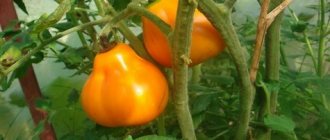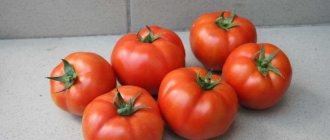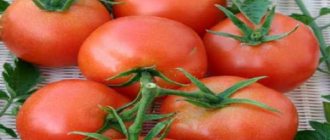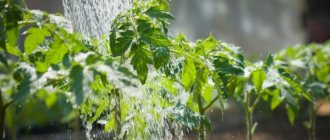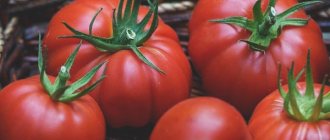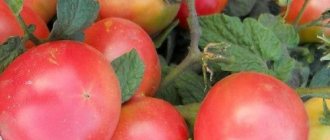Main characteristics of the plant
The same tomato variety may have different names from seed producers. Tomatoes Lamp can be called Aladdin's Lamp and Light Bulb. In addition, there is a separate variety from the category of cherry Bulb pink, which differs in the size of the bush and the size of the fruit.
The Aladdin's Lamp tomato bush is of an indeterminate type; in a greenhouse it can reach 1.8 m. In the ground it is usually lower: the tops of the bushes need to be pinched around mid-August. This allows the very last bunches to fill well, and they can be collected even in an unripe form. The stems of the plant require garter to the trellis. It is advisable to form them into 2-3 stems, not allowing the shoots to grow.
Reviews from those who planted Lampa tomatoes characterize the variety as resistant to temperature changes and a consistently productive tomato. It copes with stress during changing weather and severe cold snaps, and is able to withstand heat and dry soil without dropping its buds. With good care of the plant, the yield can be 4-5 kg of marketable products from 1 bush, regardless of the weather.
The Lampa tomato is a mid-season variety, the first ripe fruits can be obtained only in the second half of summer. Therefore, in the northern regions it is recommended to grow it in greenhouses or greenhouses, and at the latitude of Altai, in the southern Siberian steppes and Primorye - in open ground. In this case, part of the crop will have to be harvested at milky and blue ripeness.
The characteristics and description of the variety in the State Register of Breeding Achievements indicate the relative resistance of the variety to late blight. Late tomatoes in any case become infected with a fungal infection, and the vegetable grower may lose part of the harvest. To prevent this in especially difficult years, it is recommended to treat bushes with green tomatoes with fungicidal preparations.
A preventive measure can be the removal of the lower leaves (1/3 of the plant). The Aladdin's Lamp variety is resistant to summer fungal diseases (macrosporium, fusarium wilt, etc.).
Features of cultivation, planting and care
We recommend sowing the seeds of this tomato for seedlings 60-65 days before the intended planting in the ground. Seedlings dive at the stage of two true leaves. When planting seedlings in a permanent place per 1 sq. It is recommended to place up to 4 plants per meter of land.
Further care for tomatoes consists of timely watering, fertilizing with complex mineral fertilizer, pinching and preventive measures to protect against diseases and pests.
This is a natural variety of tomato. Therefore, we recommend taking seeds from a ripe fruit and using them for planting in subsequent seasons.
How to form tomatoes correctly, video
If you grew Aladdin's Lamp tomatoes, please write whether you liked them or not. What was the yield and taste of the fruit under your conditions? Will you grow them again? Briefly describe the advantages and disadvantages of this tomato in your opinion. If possible, attach to the comment a photo of the entire bush as a whole or individual fruits that you grew. Thank you!
Your reviews of the Aladdin's Lamp tomato and additions to the description will help many gardeners evaluate this variety more objectively and decide whether it is worth planting or not.
Description of the fruits of the Aladdin's Lamp variety
On a tomato bush, 5-7 clusters with bright tomatoes of an original shape develop. The fruits are pear-shaped, slightly reminiscent of the Truffle variety in size and shape. The golden and orange “bulbs” are aligned in size; about 10 tomatoes with an average weight of 100-120 g are usually formed in the brush. The last ovaries on the brush may have a more elongated shape (plum-shaped).
The skin of the tomatoes is dense, not rough. It practically does not crack when the fruit ripens, but in too rainy years, cracking of the fruit can prevent a good harvest. The color of the unripe fruit is light green, turns yellow when ripe, and becomes orange when biologically ripe. The surface of the fruit is smooth, without pronounced ribbing.
The pulp is fleshy, and every housewife who has planted Bulbs in her garden pays attention to this. The color is dark yellow, orange, but some of the pulp is sometimes red (in overripe tomatoes). The taste qualities are high, the tomatoes have a sweet taste with a barely noticeable piquant sourness.
Like all orange varieties, Aladdin's Lamp is rich in beta-carotene and vitamins, but is less allergenic than red tomatoes. The low acid content in the fruit allows tomatoes to be used for baby and dietary nutrition.
The variety can be used as a universal one. Dense tomatoes in blanzhesky ripeness are well suited for whole-fruit canning, and from well-ripened ones you can prepare unusually colored tomato juice. When boiled by 1/3, the mass thickens and becomes suitable for sauces and ketchups, making lecho and other canned snacks.
Description and characteristics of the variety
The lamp is of the indeterminate type, which means that the growth of the stems is not limited - they are pinched when the plant reaches a height of 1.8-2 m. Trellis are installed to provide support. Unlike bush forms, the fruiting of which ends quickly, indets throw out new inflorescences (the harvest is extended over time).
The tomato is adapted to unfavorable weather conditions - it is not afraid of heat, cold snap, or drought. The lamp has average resistance to late blight and high resistance to fusarium wilt, macrosporiosis, and other tomato diseases.
Productivity is high - 1 bush brings up to 5-10 kg of fruit, depending on growing conditions. Up to 7 clusters with smooth pear-shaped fruits are formed on each stem - their number in a cluster usually does not exceed 10 pieces. (with good care, the number of ovaries can reach 15 pieces). The average weight of each tomato is 100-120 g, the maximum is 140 g. Length is 7-12 cm.
Related article:
Tomato Heavyweight of Siberia - description and characteristics of a large-fruited variety
The fruit has an original shape and color. As it ripens, the color changes from green to yellow, and in the final phase to bright orange. A green spot sometimes remains near the stem, but this does not affect the taste.
In overripe Lampa tomatoes, the flesh acquires a pink or reddish tint. The skin is not hard, but dense, so the crop can be transported with virtually no loss. It rarely cracks - the problem only arises when there is a lot of rainfall or improper watering (a tomato can react this way to stagnant moisture).
The pulp of Lampochka tomatoes is fleshy, moderately juicy, not watery, sweet (sugar content - 5.6%). The taste is balanced with piquant sourness. There are few seeds, there are 4 or 5 seed chambers.
Related article:
How to properly pick the stems of tomatoes
Agricultural technology varieties
Lamp tomatoes are not a hybrid. The seeds can be saved for planting next season. Before sowing, pickle tomato seeds in a weak solution of potassium permanganate. Plant seeds in disinfected soil, scattering them over the surface of abundantly moist soil. Sprinkle the seeds on top with a thin layer of dry soil (0.5 cm). Cover the boxes with film and germinate the seeds at a temperature not lower than +25°C.
When shoots appear, remove the film and grow the tomatoes for 2-3 weeks. By this time, 1-3 true leaves should appear on them. At this stage of growth, the bushes must be pruned, that is, planted at a distance of 10 cm from each other. You can also replant into separate pots.
Seedlings of pear-shaped varieties often stretch out and look frail. Such plants are planted in grooves in a horizontal position. After transplantation, the plants gain green mass well, become strong and quickly produce the first tassels with flowers. At this time you need to start forming the bush.
Above 1 brush, 1 side shoot (stepson) is left. The rest of the growth must be removed until the second cluster with flowers grows. You need to leave 1 more shoot above it so that the plant has 3 trunks. Soon tassels of flowers will also begin to form on them.
To grow large tomatoes for fresh consumption, you can remove some of the ovaries from the brush, leaving 5-7 pieces. near the trunk of the plant that sets first. During fruiting, the bushes are fed and watered, since moisture is needed to fill the fruits. But if there is too much water, the tomatoes will be tasteless. If there is no precipitation, watering is done 1-2 times a week. In this case, you need to pour at least 10 liters of water under each bush.
Description of tomato Aladdin's Lamp
This tomato variety has several names: Lamp, Light Bulb and Aladdin's Lamp. The plants received this name because of the shape of the ripe fruits. Vegetables of this variety are actually shaped like small light bulbs or lamps. The nightshade crop of this variety is classified as interdeterminate (the main characteristic is that the height of the main stem is unlimited); the bushes can grow up to 2 meters.
After planting young seedlings in open ground, they must be tied to a vertical support. It is recommended to form the bushes into one main stem. Lower leaves and side shoots should be removed regularly to increase tomato yield. It is recommended to pinch the growing point during the growing season.
Tomatoes are mid-season varieties. From the moment the first shoots appear until the first harvest from the plot is harvested, as a rule, 114 to 120 days pass. The very first inflorescence of the plant is formed above the 9th leaf, the subsequent ones - every 3 leaves. To plant seedlings of this variety, it is advisable to choose open sunny areas or partial shade. The soil should be light and fertile.
The Aladdin's Lamp tomato variety is suitable for cultivation in garden beds, greenhouses, and film shelters.
Tomato Aladdin's Lamp: variety characteristics, description, reviews, yield
Aladdin's lamp is a mid-season variety of yellow tomatoes that can be successfully grown in greenhouses and open ground. A tall tomato bush requires mandatory care to obtain a large vegetable harvest.
Aladdin's lamp is a mid-season indeterminate tomato variety. Often, a tomato bush grows up to 1.8-2 meters, as a result of which mandatory gartering to the support and treatment of the stepsons is required. The best yield indicators can be obtained when forming a tomato bush with 2 stems. The first inflorescence is usually laid above the 9th leaf, the subsequent ones - every 3 leaves.
The main differences between Aladdin's Lamp tomatoes:
- pear-shaped;
- slight ribbing near the stalk;
- dense structure;
- yellow-orange color;
- The weight of the fruit is usually 150-300 grams.
Yellow tomatoes of the Aladdin's Lamp variety attract many gardeners who really dream of getting a rich and high-quality harvest.
Advantages and disadvantages of the variety
Yellow Aladdin's Lamp tomatoes have numerous important benefits:
- guaranteed receipt of the optimal volume of harvest, thanks to which the work of gardeners is justified;
- pleasant taste characteristics, as there is sweetness and no sourness;
- nutritional composition, because ripe fruits have a high content of beta-carotene;
- the possibility of planting the Aladdin's Lamp variety in open and closed ground, as a result of which many gardeners have a good opportunity to successfully grow vegetables;
- possibility of long-term storage of crops;
- universal use of tomatoes in cooking, and they are ideal for preparing fresh salads and canning;
- original shape and decent presentation.
The above benefits of yellow tomatoes Aladdin's lamp guarantees a good harvest. In addition, the vegetable crop in question has no disadvantages.
Rules for growing the variety
Note! Tomatoes of the Aladdin's Lamp variety can be grown successfully if you follow the sowing time and choose fertile soil.
It is best to plant a tomato in an area in the sun or partial shade, since successful cultivation of tomatoes still requires lighting.
It is best to plant Aladdin's Lamp tomatoes in a permanent place in the second half of May, since the vegetable crop needs heated soil and even at night it is advisable to cover the seedlings with a warm cloth for additional protection from the cold.
To obtain a decent harvest, namely up to 4 kilograms from one bush, you must comply with all deadlines and recommendations for placing tomato bushes. For example, it is recommended to grow the Aladdin's Lamp variety using a 40x60 planting pattern. Tomato bushes take up a lot of space, so you will need a lot of space between them.
Before planting seedlings in a permanent place, it is advisable to add organic and mineral fertilizers to the soil. Preference is usually given to fertilizers containing potassium and phosphorus, manure, chicken droppings, and wood ash. Pre-application of fertilizer significantly increases the chances of obtaining a rich harvest.
What comprehensive care is required to grow Aladdin's Lamp tomatoes?
- Regular application of fertilizers that include all recommended nutritional components becomes mandatory. This fertilizer contributes to the successful cultivation of yellow tomatoes and a guaranteed rich harvest.
- Working with the soil (weeding, loosening) is a mandatory activity. With such procedures, the supply of oxygen and the absorption of nutrients improves. Moreover, working with soil is successfully combined with removing weeds.
- Watering is a must. However, it is advisable to carry out the first watering no earlier than a week later. In the future, tomatoes are watered once every 5-7 days. In addition, drip irrigation, which is the best and most suitable, involves moistening the soil and improving the condition of tomato bushes.
- Preventive measures eliminate the risk of developing diseases and pest damage to tomato bushes. Initially, special drugs are used. However, when ripening tomatoes, only folk remedies are used.
Such comprehensive care for Aladdin's Lamp variety tomatoes is mandatory. The main task is to create the best conditions for growing yellow tomatoes and increasing the chances of getting a rich harvest.
Reviews
Kirill:
“Vegetable gardening is my hobby. I really love growing different vegetables. Moreover, new varieties are so interesting to try. Yellow tomatoes of the Aladdin's Lamp variety turned out to be one of the best. In the future I also plan to grow them.”
Milana:
“I grow Aladdin’s Lamp tomatoes almost every summer. Easy care, rich harvest and impeccable taste of tomatoes are the main advantages of the Aladdin’s Lamp variety.”
Source: https://otomate.ru/tomat-lampa-aladdina.html
Characteristics of tomato fruits Light bulb
The fruits of this variety are small, the mass of ripe vegetables is from 150 to 250 g. Tomatoes are pear-shaped; there may be ribbing and a green spot near the stalk.
Unripe tomatoes are light green in color, ripe ones are rich yellow. Overripe fruits may have red flesh. The skin is dense. The length of the fruits reaches from 7 to 12 cm. Tomatoes of this variety are collected in large clusters, each of which contains 10-15 fruits. From one adult bush you can harvest up to 10 kg of vegetables.
The collected fruits can be stored for a long time without spoiling. Tomatoes can be eaten fresh, added to salads and refried for cabbage soup. Tomatoes are also suitable for making sauces and ketchups.
Advantages and disadvantages of tomato Aladdin's lamp
- Stable yield;
- Ripe fruits taste good, as stated by ;
- High beta-carotene content in mature vegetables;
- After harvesting, the fruits can be stored for a long time;
- Universal use in cooking, well suited for preparing salads;
- Seedlings can be planted both in open and closed ground;
- Unusual shape of tomatoes;
- Suitable for preservation in its entirety; tomatoes in jars do not crack and retain their shape.
No significant deficiencies were identified in the Lampa tomato variety.
Other varieties of Bulbs
There are 2 more varieties known that bear a similar name - they also have a pear-shaped shape, but differ in color:
- Marmalade bulb - dark burgundy fruits, with “gatherings” near the base (average weight - 150 g), a carpal variety, indeterminate, late-ripening;
- Lampa (Siberian selection) is a mid-early, determinate variety, the fruits are red, their average weight is 90-110 g, universal purpose.
These varieties are significantly inferior in popularity to Aladdin's Lamp, but also deserve attention. Agricultural technology is similar.
Tomato Bulb is characterized by good seed germination. Gardeners are attracted by the unusual shape and pleasant taste of the fruit and the transportability of the harvest. Powerful plants have good immunity to diseases and produce stable yields even in unfavorable weather conditions. They can be grown both in greenhouses and in open beds. The only drawback is the need for tying and molding during growth.
source
Planting a tomato Aladdin's lamp
Growing the Light Bulb tomato variety is quite simple; even a beginner can cope with this task. First of all, before planting seedlings in open ground, you need to make sure that the soil is fertile. It is better to choose places for planting in the sun or partial shade.
A stable harvest can be obtained if seedlings are planted according to the 40 X 60 pattern. The distance between each bush should be large, since tomato bushes of this variety take up a lot of space. Before planting seedlings in a permanent place, it is recommended to add mineral and organic fertilizers to the soil. This could be potassium or phosphorus-containing fertilizers, manure, chicken droppings or wood ash.
You can begin to prepare the soil for planting tomatoes in the fall, immediately after the entire harvest has been harvested. First, they dig it up and add humus or wood ash. In the spring, you need to dig up the soil and water the tomato beds with a solution of potassium permanganate before planting. Using an aqueous solution of potassium permanganate, you can disinfect the soil and get rid of all harmful insects that have spent the winter in the ground.
Next, you can begin planting seedlings. The best time for this is the second half of May. When planting, seedlings should not be buried too deep, unless they have stretched out too much during their stay at home. After planting, the bushes must be watered with warm water and covered with a warm cloth overnight. Throughout the growing season, tomatoes should be fed with various fertilizers.
Collecting seeds
Since Lamp is a variety and not a hybrid, gardeners can prepare their own seeds for the next season. To do this, choose a fully ripened large fruit without flaws. If necessary, it can be left on the south window for ripening.
The tomato is cut crosswise so that the seed chambers become visible, and the contents are removed using the handle of a teaspoon. To free the seeds from the amniotic pulp, they are immersed in a jar of water at room temperature and left for several days.
The signal for the start of the next stage is the floating of the seeds to the surface and clouding of the liquid. At this moment, the contents of the jar are mixed, poured into a larger container, clean water is added and the liquid is whisked. As a result of this, pulp and empty seeds unsuitable for germination will float, and future planting material will sink to the bottom. The debris is removed, the cloudy liquid is drained, the seeds are filled with clean water and the contents of the container are whisked again. The procedure is repeated until complete cleansing.
Related article:
Tomato Heavyweight of Siberia - description and characteristics of a large-fruited variety
The next stage is drying. The resulting seeds are thrown onto a sieve, laid out in 1 layer on clean paper and left in a dry, warm place. Drying takes at least a week. If the seeds are stuck together, after drying they will easily separate when rubbed between your fingers.
For storage, seeds can be placed in match boxes or in thick paper bags. They need to be stored in a dry place. You should definitely sign the title.
The germination of tomato seeds Bulb lasts for 3 years.
Reviews from gardeners about Lampochka tomatoes
Reviews from those gardeners who grew this variety at their summer cottage.
Also, some gardeners who planted the variety note that deformed fruits then grow from double inflorescences.
“I’ve been growing tomatoes for several years. The yield was always good, the tomatoes were sweet, but not as sweet as the manufacturer promised, there was a slight sourness. The tomatoes were good for canning; they looked very nice in the jars.”
Valentina, 43 years old
“I’ve been planting the Light Bulb variety for the first year. The harvest was not too abundant, but not scanty either. There may be a reason in the soil; in our area the soil is not very fertile. I'll try to plant again next year. The whole family was satisfied with the taste of the tomatoes.”
“I’ve been growing Aladdin’s Lamp tomatoes for about two years. The variety always pleased with its stable harvest, but the taste of the tomatoes was not up to par. Vegetables are more suitable for pickling than for eating fresh.”
Description of tomato Aladdin's Lamp
This tomato variety has several names: Lamp, Light Bulb and Aladdin's Lamp. The plants received this name because of the shape of the ripe fruits. Vegetables of this variety are actually shaped like small light bulbs or lamps. The nightshade crop of this variety is classified as interdeterminate (the main characteristic is that the height of the main stem is unlimited); the bushes can grow up to 2 meters.
After planting young seedlings in open ground, they must be tied to a vertical support. It is recommended to form the bushes into one main stem. Lower leaves and side shoots should be removed regularly to increase tomato yield. It is recommended to pinch the growing point during the growing season.
Tomatoes are mid-season varieties. From the moment the first shoots appear until the first harvest from the plot is harvested, as a rule, 114 to 120 days pass. The very first inflorescence of the plant is formed above the 9th leaf, the subsequent ones - every 3 leaves. To plant seedlings of this variety, it is advisable to choose open sunny areas or partial shade. The soil should be light and fertile.
Characteristics of tomato fruits Light bulb
The fruits of this variety are small, the mass of ripe vegetables is from 150 to 250 g. Tomatoes are pear-shaped; there may be ribbing and a green spot near the stalk.
Unripe tomatoes are light green in color, ripe ones are rich yellow. Overripe fruits may have red flesh. The skin is dense. The length of the fruits reaches from 7 to 12 cm. Tomatoes of this variety are collected in large clusters, each of which contains 10-15 fruits. From one adult bush you can harvest up to 10 kg of vegetables.
See also Characteristics and description of the Kumato tomato variety, its yield Read
The collected fruits can be stored for a long time without spoiling. Tomatoes can be eaten fresh, added to salads and refried for cabbage soup. Tomatoes are also suitable for making sauces and ketchups.
Advantages and disadvantages of tomato Aladdin's lamp
Description of advantages:
- Stable yield;
- Ripe fruits taste good, as stated by ;
- High beta-carotene content in mature vegetables;
- After harvesting, the fruits can be stored for a long time;
- Universal use in cooking, well suited for preparing salads;
- Seedlings can be planted both in open and closed ground;
- Unusual shape of tomatoes;
- Suitable for preservation in its entirety; tomatoes in jars do not crack and retain their shape.
No significant deficiencies were identified in the Lampa tomato variety.
Planting a tomato Aladdin's lamp
Growing the Light Bulb tomato variety is quite simple; even a beginner can cope with this task. First of all, before planting seedlings in open ground, you need to make sure that the soil is fertile. It is better to choose places for planting in the sun or partial shade.
A stable harvest can be obtained if seedlings are planted according to the 40 X 60 pattern. The distance between each bush should be large, since tomato bushes of this variety take up a lot of space. Before planting seedlings in a permanent place, it is recommended to add mineral and organic fertilizers to the soil. This could be potassium or phosphorus-containing fertilizers, manure, chicken droppings or wood ash.
You can begin to prepare the soil for planting tomatoes in the fall, immediately after the entire harvest has been harvested. First, they dig it up and add humus or wood ash. In the spring, you need to dig up the soil and water the tomato beds with a solution of potassium permanganate before planting. Using an aqueous solution of potassium permanganate, you can disinfect the soil and get rid of all harmful insects that have spent the winter in the ground.
See also Description of the Japanese tomato variety and its characteristics Read
Next, you can begin planting seedlings. The best time for this is the second half of May. When planting, seedlings should not be buried too deep, unless they have stretched out too much during their stay at home. After planting, the bushes must be watered with warm water and covered with a warm cloth overnight. Throughout the growing season, tomatoes should be fed with various fertilizers.
Agricultural technology
For planting, choose an area with light, fertile soil. It should be located in the sun or partial shade. In open ground, tomatoes of the Lampochka variety are grown in temperate latitudes and in the south of the Russian Federation. In the northern regions, seedlings are planted in greenhouses.
Related article:
How to water tomatoes correctly?
Growing seedlings
Sowing of seedlings is carried out 60-65 days before the planned transplant. Optimal timing:
- from late February to mid-March - in the south;
- from mid-March to early April - in the central regions;
- April 1-15 – in the north.
Since the plant is indeterminate, it needs a nutrient medium. A mixture of sand, humus, peat, and garden turf (1:1:1:2) is suitable for growing seedlings. To disinfect the soil, it is watered with a strong solution of potassium permanganate. Sowing begins after 10-12 days - by this time beneficial bacteria are developing in the substrate.
Seeds are soaked for a day in a soda solution (1 g/200 ml of water) - it disinfects them and accelerates germination. After processing, they are washed and dried. The prepared planting material is sown in moist soil to a depth of 1.5 cm, sprinkled with loose substrate on top and covered with glass or film. The distance between the grooves is 3-4 cm, between seedlings - 1-2 cm. A spray bottle is used for watering. The glass (film) is opened daily for ventilation. The optimal temperature is 25…30°C.
Related article:
Growing tomatoes without seedlings - varieties, advantages and disadvantages of the method
Seedlings hatch in about 5 days. The containers with them are moved to a sunny window, additional lighting is organized - the length of daylight hours should be 12-16 hours. The temperature is maintained at 23°C for 14 days, then it is reduced to 18°C.
Before picking, seedlings do not need fertilizing. Transplantation into separate cups (pots) is carried out when two true leaves appear.
The pots prepared for transplantation are filled with substrate mixed with complex fertilizer (such as Signor Tomato - 1 tbsp per 5 l). After 2 weeks, the seedlings are fed with nitroammophoska (1 tbsp per 10 l). After another 2 weeks, fertilizing is repeated. The next feeding includes superphosphate (0.5 tbsp) and ash (1 tbsp) - this amount of fertilizer is calculated for 5 liters (0.5 tbsp is consumed for each seedling).
Related article:
Growing tomato seedlings in milk
A week before transplantation, the seedlings begin to harden, lowering the temperature (the pots are taken to a cool room or ventilated without drafts). Hardening is carried out gradually, starting from an hour and increasing the time to a day. Watering during this period is done less frequently.
If a flower brush has formed on the plant, then it is sprayed with a solution of boric acid (1 tsp/1 liter of hot water). This will prevent it from falling off.
Planting seedlings
60-65 days after sowing, the grown seedlings are transplanted into open ground - by this time 6-7 true leaves are formed on the stem, reaching a height of 25-35 cm.
The soil is prepared in the fall by digging it up and adding fertilizers: 1 bucket of compost, 1 tbsp. per 1 sq.m. ash and 30 g of superphosphate. In the spring, the area is dug up, watered with a solution of potassium permanganate for disinfection and loosened.
On the day of transplantation, the seedlings are watered abundantly. The optimal layout is 40x60 cm. This distance is necessary because Lampa tomatoes grow powerful, and their root system takes up a lot of space. The depth of the holes should be such that the seedling can be immersed up to the cotyledon leaves. This is necessary for the formation of a powerful root system. After filling the holes with soil, the plants are watered with warm water and the soil is mulched.
Related article:
Fertilizers for tomatoes
Overgrown tomatoes are planted at an angle. This prevents the roots from sinking into the frozen ground. The stem is tilted to the north - since plants always reach towards the sun, over time they take the correct position.
Molding
Tomato Bulb, in accordance with the characteristics of the variety, is recommended to be formed into 1 stem (it is necessary to remove all stepsons as they appear).
If you choose the option of molding into 2 stems, then one side shoot is left above the first brush, and all the others are removed. If there are 3 stems, then the stepson is not removed above the second flower cluster. The growing point is pinched at the end of the growing season.
Installation of supports
Indeterminate Lamp tomatoes are most conveniently grown on trellises. To arrange them, at the beginning and at the end of the row, 2 supports are dug into the ground, retreating 10 cm from the outer bushes so as not to damage the roots. If the bed is long, then the number of supports is increased. Several rows of wire are placed between the beams, to which the stems will be tied as they grow. For gartering, soft material is used - twine or fabric scraps. Do not tighten the knots too much so that the stems do not get damaged.
Related article:
Tomato science. options for forming tomato bushes
Watering
When watering, it is worth considering that Lampa tomatoes react poorly to excess moisture - the pulp becomes watery and less sweet. A moisture deficiency should also not be allowed - despite its resistance to drought, the plant experiences stress and fruiting slows down.
It is recommended to water the beds once every 3-4 days in the absence of precipitation and moderately hot weather. If the heat is scorching, the frequency of watering is increased; if it rains, it is reduced.
The optimal soil moisture for Lampochka tomatoes is 85-90%, air humidity is no more than 50%. Water consumption for 1 adult bush is about 10 liters. Watering is carried out early in the morning at the root.
The water should be settled and heated in the sun - you can install a tank on the site and paint it with black paint. When watering with a hose, it is important to ensure that the cold streams do not hit the leaves. After watering, the soil is loosened shallowly and mulched with straw.
Related article:
Varieties of pink tomatoes Eagle beak and Eagle heart
Feeding
Opinions differ on how to feed indeterminate tomatoes. According to one version, it is worth applying fertilizer every 2 weeks, according to another - 3 or 4 times throughout the season. If the option with four times feeding is chosen, then the following compositions are sequentially applied (the norms are based on 10 liters of water):
- Nitrophoska and liquid mullein (1 tbsp/500 ml);
- Potassium sulfate, superphosphate, chicken manure (1 tsp/1 tbsp/500 g);
- Nitrophoska and potassium humate (1 tbsp each);
- Superphosphate (1 tbsp).
Consumption rates for 1 bush:
- feeding No. 1 and No. 2 – 500 ml each;
- No. 3 – 5 l/sq.m;
- No. 4 – 10 l/sq.m.
If frequent feeding is planned (once every 10-14 days), then prepare a complex composition, including:
- nettles – 5 buckets;
- ash - 2 shovels;
- yeast – 2 kg;
- mullein - 1 bucket;
- whey – 3 l.
Related article:
Growing tomato seedlings at home
The mass is placed in a 200 liter barrel, warm water is added and left to infuse for 2 weeks. Each bush consumes 1 liter. Additionally, to prevent the ovaries from falling off, you can spray the above-ground part with a solution of boric acid (1 g/1 l).
